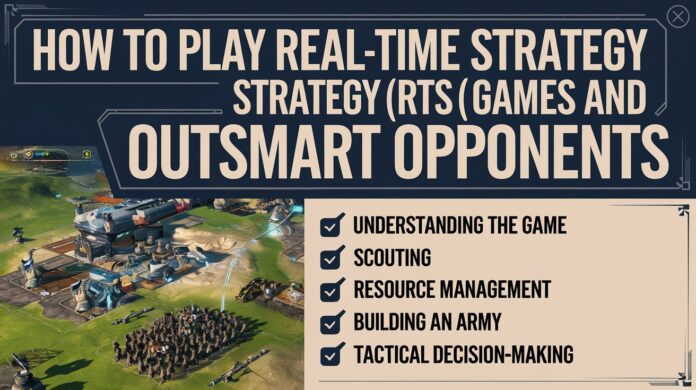Real-time strategy (RTS) games offer some of gaming’s most exhilarating and intellectually stimulating experiences. From commanding vast armies to managing resources and outmaneuvering opponents, these games test your decision-making abilities under pressure like few others. Whether you’re a complete newcomer curious about the genre or a casual player looking to elevate your skills, this comprehensive guide will equip you with the knowledge and strategies to dominate the battlefield.
Understanding the RTS Genre
Real-time strategy games are defined by their unique blend of resource management, base building, technological advancement, and tactical combat—all happening continuously rather than in turns. Unlike turn-based strategy games where you have unlimited time to consider your moves, RTS games require quick thinking and execution as events unfold in real-time.
Core Elements of RTS Games
Most RTS games share these fundamental components:
- Resource gathering: Collecting materials like minerals, gas, wood, gold, or energy to fund your war effort
- Base construction: Building structures that produce units, research technologies, and defend your territory
- Unit production: Creating various military units with different strengths and weaknesses
- Technology progression: Researching upgrades that improve your capabilities
- Combat: Engaging enemy forces through tactical positioning and unit ability usage
Popular RTS titles include classics like StarCraft II, Age of Empires series, Command & Conquer series, and newer entries like Company of Heroes 3, Age of Empires IV, and Homeworld 3.
Essential Skills for RTS Success

Mastering the Fundamentals: Macro Management
Macro management refers to the big-picture aspects of RTS gameplay—economy, production, and overall strategy. No matter how skilled your combat micro-management might be, poor macro will leave you without the resources or units needed to succeed.
Economy Management
Your economic foundation determines everything else you can accomplish:
- Constant worker production: Never stop building workers until you reach the optimal number (typically 60-80 workers depending on the game)
- Resource saturation: Ensure each resource location has the ideal number of workers assigned to it
- Expansion timing: Know when to establish new bases to access additional resources
- Supply management: Always stay ahead on supply/population capacity to avoid production blocks
Production Efficiency
Keeping your production facilities constantly active is crucial:
- Production cycles: Develop rhythms for checking and activating production facilities
- Queuing discipline: Avoid excessive unit queuing that ties up resources unnecessarily
- Hotkeys mastery: Learn production hotkeys to build quickly without looking away from the action
- Production facility scaling: Add additional production buildings as your economy grows
Refining Your Micro Management
Micro management involves the detailed control of individual units or small groups:
- Unit positioning: Place units to maximize their effectiveness while minimizing vulnerability
- Ability activation: Time special abilities for maximum impact
- Focus firing: Concentrate damage on high-value targets
- Kiting: Attack and retreat with ranged units to deal damage while avoiding it
- Unit preservation: Retreat damaged units to preserve their value and experience
Building Game Awareness
Superior awareness of game state often determines the winner:
- Map control: Use scouts, observers, or cheap units to monitor the map
- Enemy tracking: Keep tabs on opponent army movements and base locations
- Timing awareness: Develop an internal clock for when key technologies or units typically appear
- Resource monitoring: Track both your resources and estimate your opponent’s economic status
Developing a Strategic Mindset

Understanding Build Orders
Build orders are optimized sequences of actions that maximize efficiency in the early game:
- Standard openings: Learn 2-3 reliable build orders for your preferred faction
- Benchmarks: Know key timing benchmarks (e.g., “50 supply by 5:00”)
- Adaptability: Understand when and how to deviate based on scouting information
- Practice routine: Perfect build orders against AI before using them against human opponents
Countering Enemy Units
Every RTS implements a complex rock-paper-scissors relationship between unit types:
- Unit counter knowledge: Memorize which units counter others in your chosen game
- Scouting integration: Adjust your production based on what you scout
- Composition transitions: Develop the skill to smoothly transition between army compositions
- Mixed armies: Create balanced forces that cover their own weaknesses
Battle Tactics That Win Games
Victory often comes down to how effectively you engage the enemy:
- Engagement selection: Choose when and where to fight based on terrain and army composition
- Flanking maneuvers: Attack from multiple directions to surround enemies
- Concave formations: Spread units in a curved formation to maximize attacking units
- Focus fire discipline: Train yourself to systematically eliminate high-value targets
- Retreat recognition: Know when to disengage from unfavorable battles
Advanced Strategies to Outsmart Opponents
Reading Your Opponent
Top players develop the ability to predict opponent actions:
- Pattern recognition: Notice recurring behaviors in your opponent’s play style
- Psychological warfare: Use feints and decoys to manipulate opponent decisions
- Adaptation: Adjust your strategy based on your opponent’s tendencies
- Metagame awareness: Understand current popular strategies and their counters
Effective Multitasking Techniques
RTS games require managing multiple situations simultaneously:
- Attention cycling: Develop a rhythm for cycling attention between economy, production, and combat
- Task prioritization: Quickly determine which actions yield the highest value
- Automation utilization: Use in-game automation features (like rally points and patrol commands) effectively
- APM improvement: Gradually increase your actions per minute through deliberate practice
Map Control and Vision
Information is perhaps your most powerful weapon:
- Observer placement: Position detection units at key pathways and expansions
- Denial tactics: Eliminate enemy vision capabilities when possible
- Expansion control: Contest resource locations even if you can’t take them yourself
- Watch tower usage: Utilize game-specific vision-granting structures
Game-Specific Strategies

StarCraft II
As one of the most competitive RTS games ever created, StarCraft II rewards mastery of race-specific mechanics:
Terran Tactics
- Utilize drop harassment to split opponent attention
- Position siege tanks on high ground for maximum effectiveness
- Employ scan at critical moments to reveal cloaked units or scout
- Master the bio ball with stutter-step micro
Protoss Approaches
- Perfect warp-in timing for reinforcement during battles
- Use hallucination for risk-free scouting
- Position observers to track enemy movements
- Manage shield batteries to maximize unit longevity
Zerg Strategies
- Spread creep aggressively for vision and movement speed
- Use overlords and changelings for comprehensive scouting
- Implement multi-pronged attacks with zerglings
- Time production cycles with larvae injects
Age of Empires Series
This historically-themed RTS franchise rewards different skills:
- Focus on aging up at optimal times to unlock technological advantages
- Master unique civilization bonuses that can dramatically alter optimal strategies
- Control sacred sites and trade routes for alternative victory conditions
- Utilize terrain features like forests and hills for tactical advantages
Company of Heroes Series
This WWII tactical RTS emphasizes:
- Territory control through strategic point capture
- Cover utilization for infantry survivability
- Vehicle positioning to protect weak rear armor
- Resource funneling toward critical veterancy units
Common Mistakes to Avoid
Even experienced players fall into these traps:
Resource Hoarding
Stockpiling resources is rarely beneficial—they should be converted into army or economy:
- Aim to keep resources low while maintaining production
- If resources pile up, expand your production capacity or tech up
- Consider trading excess resources in games with marketplaces
Neglecting Scouting
Playing blind is a fast track to defeat:
- Schedule regular scouting activities as part of your routine
- Interpret what you don’t see as well as what you do
- Verify enemy tech paths and expansion timing
- Maintain map presence even when under pressure
Over-Micromanagement
Focusing too much on perfect unit control often comes at the expense of macro:
- Only micro when it provides significant value
- Return to macro activities between combat situations
- Use control groups efficiently to minimize micro overhead
- Recognize when “good enough” micro with better macro wins more games
Ineffective Expansion
Errors in expansion timing can be crippling:
- Expanding too early leaves you vulnerable
- Expanding too late stunts economic growth
- Each additional base increases defensive requirements
- Match expansion pace with map control capability
Training Regimen for Improvement
Structured Practice Routine
Random gameplay isn’t the most efficient way to improve:
- Focused drills: Practice specific skills in isolation (e.g., build orders, micro techniques)
- AI sparring: Use computer opponents to perfect standard openings
- Replay analysis: Review your games to identify recurring mistakes
- Benchmark testing: Regularly test yourself against standard metrics (workers at 5 minutes, etc.)
Learning from Defeats
Losses provide the most valuable learning opportunities:
- Identify losing moments: Pinpoint exactly where games turned against you
- Pattern recognition: Look for recurring weaknesses across multiple defeats
- Alternative responses: Theorize different approaches you could have taken
- Implementation plan: Create specific practice goals based on identified weaknesses
Community Resources
The RTS community offers valuable learning tools:
- Build order guides: Find optimized openings on community websites
- Pro replays: Study how top players handle situations similar to yours
- Coaching services: Consider lessons from higher-ranked players
- Discord communities: Join game-specific groups to share strategies
Mental Approach for Competitive Success
Managing Ladder Anxiety
Many players experience stress when playing ranked matches:
- Process focus: Concentrate on executing your gameplan rather than the outcome
- Reframing losses: View defeats as valuable data rather than failures
- Session limits: Set reasonable goals for game counts rather than ranking
- Physical readiness: Ensure you’re well-rested and comfortable before competing
Maintaining Focus During Long Matches
Mental stamina is crucial for extended games:
- Breathing techniques: Use deliberate breathing to stay calm in intense moments
- Attention resets: Develop triggers to refocus when you feel attention drifting
- Between-game routines: Create habits that reset your mental state between matches
- Physical movement: Stand up briefly between games to maintain alertness
Evolving with the Meta
RTS games constantly evolve as players discover new strategies:
- Community engagement: Follow forums and discussions about emerging tactics
- Patch adaptation: Quickly adjust to balance changes when updates occur
- Experimentation periods: Allow yourself time to test new approaches after major changes
- Flexible fundamentals: Build core skills that transfer between meta shifts
Conclusion: The RTS Journey
Mastering real-time strategy games is a rewarding journey that develops skills applicable beyond gaming—decision-making under pressure, resource management, strategic thinking, and performance under stress. The complex interplay of mechanics and strategy ensures that even after years of play, you’ll continue finding new depths to explore.
Remember that improvement comes gradually. Focus first on sound fundamentals—consistent economy, steady production, and basic unit control. As these become second nature, you’ll free mental bandwidth for more advanced tactics and strategies.
Whether your goal is casual enjoyment or competitive mastery, the principles outlined in this guide will help you experience the unique satisfaction that comes from outthinking and outmaneuvering your opponents in one of gaming’s most intellectually demanding genres.
Start by mastering one race or faction completely before expanding your repertoire. Be patient with yourself through the inevitable losses, and use each defeat as a stepping stone toward improvement. Before long, you’ll find yourself executing strategies you once thought impossible and experiencing the unique thrill that comes from commanding virtual armies to victory.

Zareb Saleh is a journalist at Gulf Today and a ghostwriter for Gameoholic, specializing in gaming, technology, and digital culture. With a keen eye for industry trends, he delivers insightful stories that engage and inform readers.




